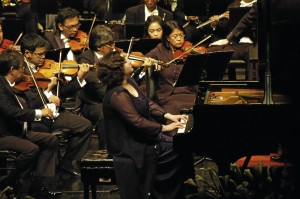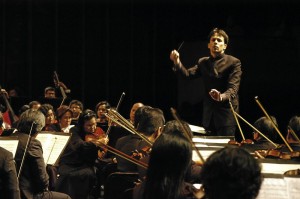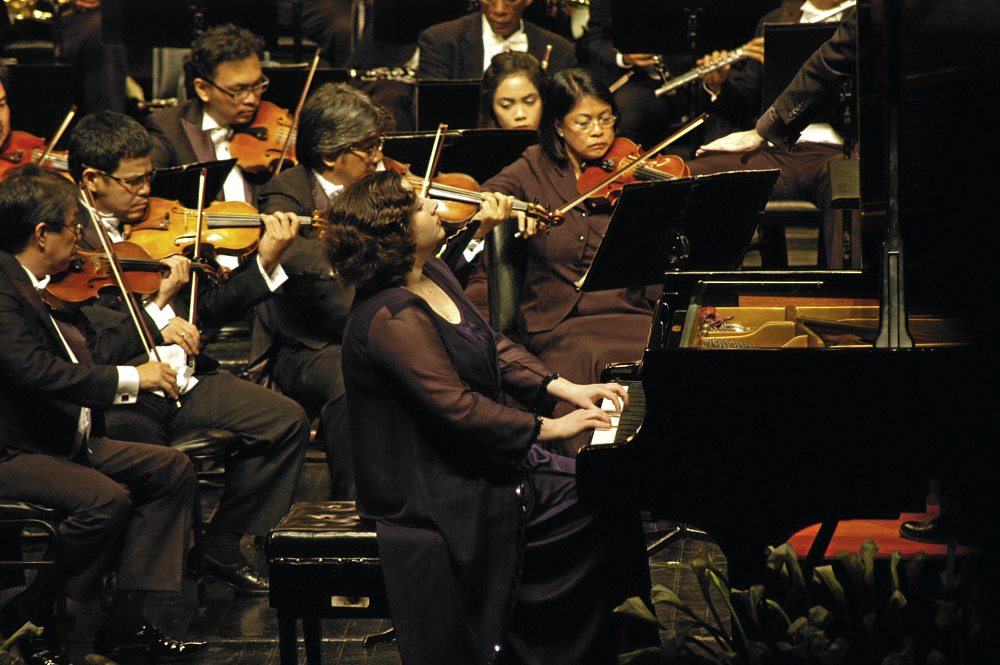
Philippine Philharmonic Orchestra’s (PPO) final concert for the season, held recently at the Cultural Center of the Philippines, ended with a bang.
Two big works made up the program that eloquently brought out the orchestra’s sterling capability under the stewardship of conductor Olivier Ochanine.
The symphonic work was no other than Igor Stravinsky’s “Le Sacre du Printemps” (Rite of Spring). The other, also written in the vein of a symphonic work was Johannes Brahms’ Piano Concerto No. 1 in D Minor. World-class pianist Sofya Gulyak was the featured soloist.
Both works had a similar unpopular reception from the audience when they were first heard, a phenomenon that had often been noted regarding great works in their initial presentations.
When Brahms’ concerto was first performed, it was considered a bit long, lasting almost an hour. It was written in a symphonic manner, even if it was cast in the classical mould, and did not have pyrotechnics for the pianist to showcase technical virtuosity, deviating from the convention then.

Instead, the work demands eloquence expressed in depth of tones, singing ability, excellent voicing to etch a symphonic sound, and ability to forge dynamic collaboration with the conductor to bring out the essence of the work.
Gulyak delivers
Gulyak arrestingly met all the above considerations. She sat at the piano with a cool stance and showed no hint of any mannerisms, or bodily movements that would help visualize the grandness of her sound. She sank her fingers deep on the keys and produced lustrous, sonorous sound of a honed pianism.
In the first movement, she strongly carved out chords that were at times played in succession (arpeggios), powerful octaves and arresting trills. Playing in a very relaxed manner, she essayed a buoyant, singing symphonic sound, conveyed through elegant phrasing that brought out the majesty of the movement.
She breezed through the long first movement in fastidious rapport with the conductor. In hushed tones, she struck a quiet second movement. Its exquisite, meditative ambiance chilled the spine of listeners. The cadenza or solo passage was played with great sublimity, with a spark of the divine.
The third movement reeled off spiritedly, delivered quite spontaneously. But as soon as she sounded the cadenza, she and the orchestra once more brought the audience into a contemplative mood.
Her majestic playing was met with shouts of bravos, long calls that quieted only with a rendition of two encores; a movement from a sonata of Clementi, and a Rachmaninof prelude, all played with burning sensitivity.
Briefly informing the audience about Stravinsky’s work premiering in 1913 which was a fiasco, and inviting them to the next season after the interval, Ochanine awed his audience as he disclosed his mettle on the podium by wielding the baton on the Stravinsky masterpiece. He rarely glanced at the score, and instead cued his musicians masterfully. Indeed, he was in glorious command.
Titan of the podium
On this my third time to hear the PPO since he assumed the baton three years ago, I could say without any doubt that Ochanine is a titan of the podium. He has definitely arrived. His boyish looks betray his ability to wield the baton maturely, not literally in a magical manner but with commanding authority.
If choreography was missing (as the work was written for a ballet), there was much of it on the podium, not for effect but as a natural articulation of the music. Through well-executed bodily movements, the youthful conductor, I should say maestro, precisely got the desired effect.
He was highly visual, but with reason, and character! He would have looked awkward if he just stood and ticked time, unmoved by the pulsating dynamism of the work.
The musicians played with gusto, essaying a cacophony of orchestral sounds that went beyond the range of some of the instruments, notably the opening bassoon’s melodic phrase sounded in the high register.
As the music needed special effects, several instruments were added thus increasing the size of the orchestra, such as alto flute, bass clarinets, piccolo trumpet, tuba and the like.
This time the musicians had the comfort of the wide stage, compared with the first time it was played in 1912, when the huge orchestra was squeezed into the pit to accompany the ballet, as maestro Ochanine said in his introductory remarks.
Indeed, today the work has become a fine symphonic piece that can be played minus the choreography.
The audience listened in awe, mesmerized with the richness of tonal colors conveyed by the dissonances, the irregular accents, the pulsating, different rhythms, the droned phrases, and above all the unpredictability of the piece, which precisely kept everyone engaged to eagerly await what would unfold next.
This is one of the rare moments I had ever seen the orchestra members played with gusto. One discerned their warm disposition, as they played their respective instruments with burning passion, making the concert truly a memorable one.
Congratulations to the PPO musicians, and of course to Maestro Ochanine. He is definitely for keeps!
Gulyak will continue to enthrall her listeners in a solo recital slated at the CCP Little Theatre on May 8, 7:30 p.m., featuring an all-Russian program that includes one of the formidable war sonatas of Prokofiev, Sonata No. 6.
Before the tickets are sold out, call CCP Box Office, tel. 8323704.
Correction
In my last article, “And the bands play on,” a portion of the text was inadvertently cut when I e-mailed my copy to Lifestyle, to beat the deadline. My apologies. Here is the excised text:
Energy and exuberance characterized the performance of the UP Symphonic Band, led by Rodney Ambat. Valentin Mechilina’s “Dalampasigan,” an overture, was a tour de force to the otherwise percussive rendition of the pieces that preceded it, namely, Richard Saucedo’s “Persistence” and Philip Sparke’s “The Year of the Dragon.”
Toning down the percussion instruments, the snare drum among them, to blend with the rest of the band, would help achieve maximum effect and make the rendition more celebrative rather than plain bravura.
In “Dalampasigan,” the band’s symphonic ambiance, resplendent and buoyant, was best appreciated. The musicians essayed good rapport. Ensemble work to etch rich voicing or tonal balance was marvelous. The musicians played well, especially the clarinets that dished out those difficult running passages with ease and clarity.
The festival was participated in by Angono Wind Ensemble; Baguio City National High School Special Program in the Arts Band; Banda 11 of Cabiao, Nueva Ecija; Bukidnon State University Band; Citizen’s Brigade Band of Dasmariñas, Cavite; Hiyas ng Bulacan Brass Band; International School Manila Symphonic Band; Pasay City Composite Band; Philbanda Wind Orchestra; Philippine Air Force Band; Philippine Army Band; Philippine Coast Guard Symphonic Band; Philippine Navy Band; Philippine Youth Symphonic Band; Sto. Tomas Community Band of Sto. Tomas, Batangas; University of the Philippines Symphonic Band; and University of Sto. Tomas Wind Orchestra.













































